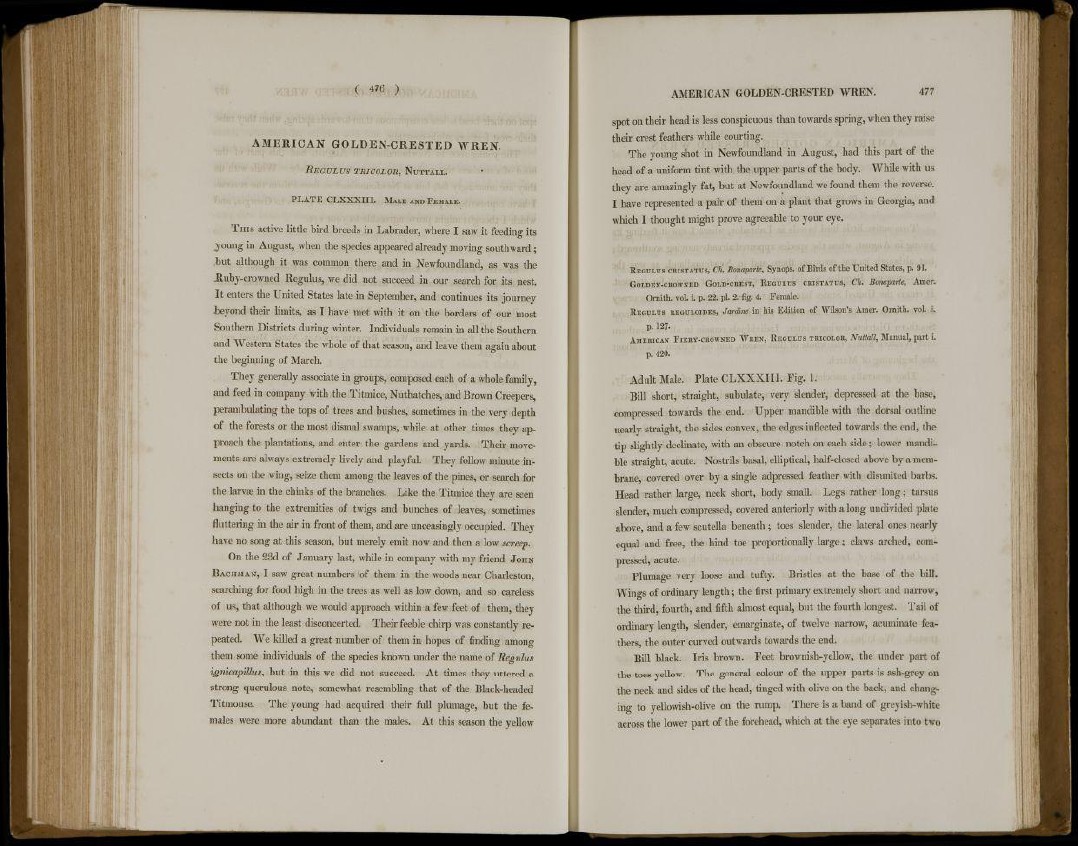
( 4 7 6 )
AMERICAN GOLDEN-CRESTED WREN.
REGULUS TRICOLOR, NUTTALL.
P L A T E C L X X X I I I . MALE AND FEMALE.
THIS active little bird breeds in Labrador, where I saw it feeding its
.young in August, when the species appeared already moving southward ;
but although it was common there and in Newfoundland, as was the
Huby-crowned Regulus, we did not succeed in our search for its nest.
It enters the United States late in September, and continues its journey
beyond their limits, as I have met with it on the borders of our most
Southern Districts during winter. Individuals remain in all the Southern
and Western States the whole of that season, and leave them again about
the beginning of March.
They generally associate in groups, composed each of a whole family,
and feed in company with the Titmice, Nuthatches, and Brown Creepers,
perambulating the tops of trees and bushes, sometimes in the very depth
of the forests or the most dismal swamps, while at other times they approach
the plantations, and enter the gardens and yards. Their movements
are always extremely lively and playful. They follow minute insects
on the wing, seize them among the leaves of the pines, or search for
the larvae in the chinks of the branches. Like the Titmice they are seen
hanging to the extremities of twigs and bunches of leaves, sometimes
fluttering in the air in front of them, and are unceasingly occupied. They
have no song at this season, but merely emit now and then a low screep.
On the 23d of January last, while in company with my friend JOHN
BACHMAN, I saw great numbers of them in the woods near Charleston,
searching for food high in the trees as well as low down, and so careless
of us, that although we would approach within a few feet of them, they
were not in the least disconcerted. Their feeble chirp was constantly repeated.
We killed a great number of them in hopes of finding among
them some individuals of the species known under the name of Regulus
ignicapillus, but in this we did not succeed. At times they uttered a
strong querulous note, somewhat resembling that of the Black-headed
Titmouse. The young had acquired their full plumage, but the females
were more abundant than the males. At this season the yellow
AMERICAN GOLDEN-CRESTED WREN. 477
spot on their head is less conspicuous than towards spring, when they raise
their crest feathers while courting.
The young shot in Newfoundland in August, had this part of the
head of a uniform tint with the upper parts of the body. While with us
they are amazingly fat, but at Newfoundland we found them the reverse.
I have represented a pair of them on a plant that grows in Georgia, and
which I thought might prove agreeable to your eye.
REGULUS CRISTATUS, Ch. Bonaparte, Synops. of Birds of the United States, p. 91.
GOLDEN-CROWNED GOLD-CREST, REGULUS CRISTATUS, Ch. Bonaparte, Amer.
Ornith. vol. i. p. 22. pi. 2. fig. 4. Female.
REGULUS REGULOIDES, Jardine in his Edition of Wilson's Amer. Ornith. vol. i.
p. 127-
AMERICAN FIERY-CROWNED WREN, REGULUS TRICOLOR, Nuttall, Manual, part i.
p. 420.
Adult Male. Plate CLXXXIII. Fig. 1.
Bill short, straight, subulate, very slender, depressed at the base,
compressed towards the end. Upper mandible with the dorsal outline
nearly straight, the sides convex, the edges inflected towards the end, the
tip slightly declinate, with an obscure notch on each side; lower mandible
straight, acute. Nostrils basal, elliptical, half-closed above by a membrane,
covered over by a single adpressed feather with disunited barbs.
Head rather large, neck short, body small. Legs rather long; tarsus
slender, much compressed, covered anteriorly with a long undivided plate
above, and a few scutella beneath ; toes slender, the lateral ones nearly
equal and free, the hind toe proportionally large; claws arched, compressed,
acute.
Plumage very loose and tufty. Bristles at the base of the bill.
Wings of ordinary length; the first primary extremely short and narrow,
the third, fourth, and fifth almost equal, but the fourth longest. Tail of
ordinary length, slender, emarginate, of twelve narrow, acuminate feathers,
the outer curved outwards towards the end.
Bill black. Iris brown. Feet brownish-yellow, the under part of
the toes yellow. The general colour of the upper parts is ash-grey on
the neck and sides of the head, tinged with olive on the back, and changing
to yellowish-olive on the rump. There is a band of greyish-white
across the lower part of the forehead, which at the eye separates into two